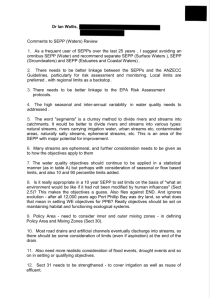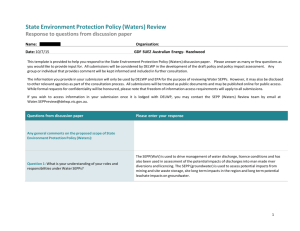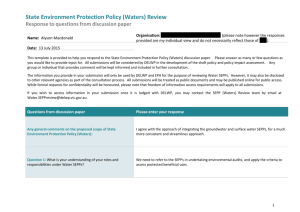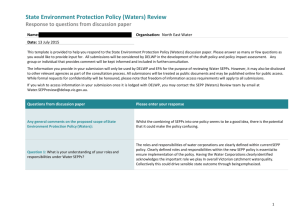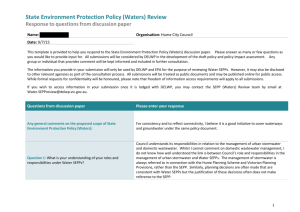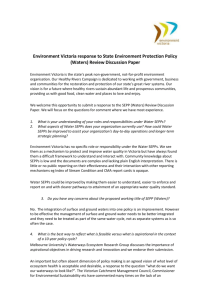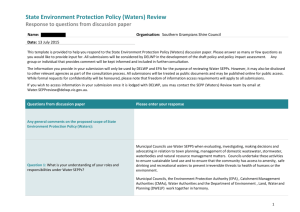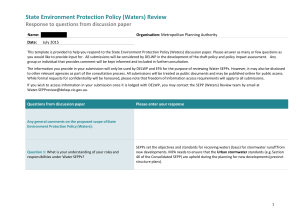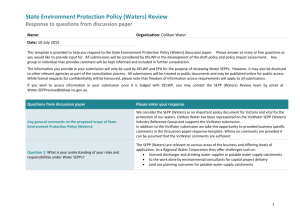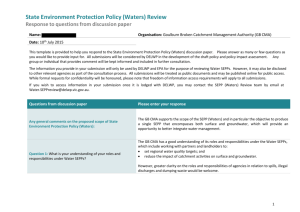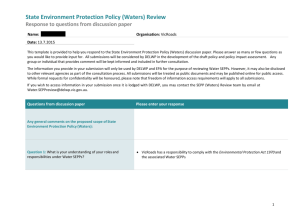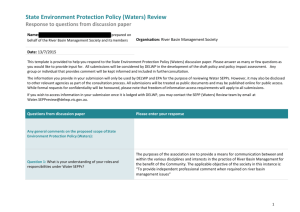Western Water (Accessible version)
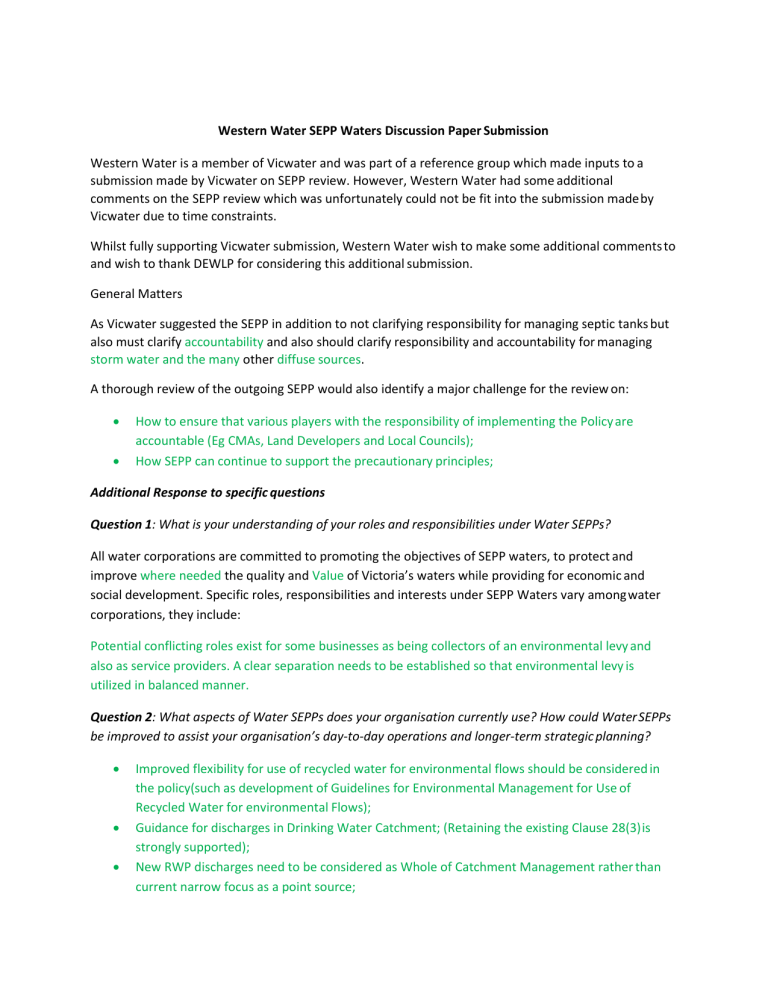
Western Water SEPP Waters Discussion Paper Submission
Western Water is a member of Vicwater and was part of a reference group which made inputs to a submission made by Vicwater on SEPP review. However, Western Water had some additional comments on the SEPP review which was unfortunately could not be fit into the submission made by
Vicwater due to time constraints.
Whilst fully supporting Vicwater submission, Western Water wish to make some additional comments to and wish to thank DEWLP for considering this additional submission.
General Matters
As Vicwater suggested the SEPP in addition to not clarifying responsibility for managing septic tanks but also must clarify accountability and also should clarify responsibility and accountability for managing storm water and the many other diffuse sources .
A thorough review of the outgoing SEPP would also identify a major challenge for the review on:
How to ensure that various players with the responsibility of implementing the Policy are accountable (Eg CMAs, Land Developers and Local Councils);
How SEPP can continue to support the precautionary principles;
Additional Response to specific questions
Question 1: What is your understanding of your roles and responsibilities under Water SEPPs?
All water corporations are committed to promoting the objectives of SEPP waters, to protect and improve where needed the quality and Value of Victoria’s waters while providing for economic and social development. Specific roles, responsibilities and interests under SEPP Waters vary among water corporations, they include:
Potential conflicting roles exist for some businesses as being collectors of an environmental levy and also as service providers. A clear separation needs to be established so that environmental levy is utilized in balanced manner.
Question 2: What aspects of Water SEPPs does your organisation currently use? How could Water SEPPs
be improved to assist your organisation’s day-to-day operations and longer-term strategic planning?
Improved flexibility for use of recycled water for environmental flows should be considered in the policy(such as development of Guidelines for Environmental Management for Use of
Recycled Water for environmental Flows);
Guidance for discharges in Drinking Water Catchment; (Retaining the existing Clause 28(3) is strongly supported);
New RWP discharges need to be considered as Whole of Catchment Management rather than current narrow focus as a point source;
Question 4: What is the best way to reflect what is feasible versus what is aspirational in the context of a
10-year policy cycle?
The policy should pave the way for better alignment of license limits with the practicality of achieving
SEPP objectives of receiving waters; ( There is a conflict between the limits specified in a Licence and the expected objectives of receiving waters and therefore the policy should have a flexibility to provide a mixing zone based on the discharge limits).
Question 5: Do you support the proposed SEPP (Waters) objective of “this policy is to protect and
improve the quality of Victoria’s waters while providing for economic and social development”? Why?
There is a need to consider the policy in context of other environmental impacts such as greenhouse gas emission to truly reflect the economic and social impacts and also need to make sure allowance is given to the step changes to the environment over time such as the significant effect of climate change.
As it is expected that the new policy will have focus on setting “off sets” as a tradeoff for increased treatment of point source discharge, there could be a benefit to make it compulsory for the development of regional catchment strategies so that catchment wide actions are identified in one document and those actions can be considered as an offset and measure outcomes.
Question 6: Do you support the need to balance economic and social development with overall
protection and improvement of water quality for Victoria’s water environments? Why?
Question 7: What are the challenges of balancing economic and social development with protecting and
improving water quality? How should we manage the appropriate trade-offs between them?
A combined response to questions 6 and 7.
Another important aspect is identifying root cause of the impacts and passes the cost to the appropriate contributors of adverse impacts so that there is a balance in accountability for expenditure. Particular concern to Water Corporations is the expectation that it should subsidize Local Government to improve storm water quality as an “off set” whilst the root cause could be Land Management in urban growth areas.
Question 9: Are there any specific types of water environments, for example, a wastewater treatment
lagoon, where you think beneficial uses should not be protected?
Consideration could be given in protecting storm water quality in the context of integrated water cycle management if it needs to be harvested for drinking water.
Question 10: Do you think the current measures for classifying surface water and groundwater segments
are still appropriate? Are there other measures that should be explored?
Question 14: Do you believe that all beneficial uses set out in Table 2 should still be protected under the
new SEPP (Waters)? Where do you think a beneficial use would not apply? Why?
There is also an opportunity to improve the segments based on the Integrated Water Management
Strategies which are being implemented across the State.
Question 15: What method or approach could be used to apply the beneficial uses to segments and sub-
segments?
Whole of water catchment approach will aid in identifying clear priorities to achieve most cost effective control measures which are balanced economically and socially;
Community education is potentially important aspect in broadening accountability for water quality and beneficial use across the state.
Question 17: What do you think about the current indicators, the approach for deriving objectives and
the proposed changes?
Once water quality objectives are derived, the mechanism to achieve those objectives should be considered as a “whole of catchment/water cycle/risk management approach”.
There should be accountability for bulk entitlement and environmental flows and flexibility to include all the available water sources for “fit for purpose” environmental flows.
The policy should include a mechanism to identify the root cause of impacts and include mechanisms to mitigate the root cause and accountability. Examples include land use planning by local government. Intervention is required for managing development within growth areas in particularly in managing the conflict between improving water quality and providing affordable housing to the community.
